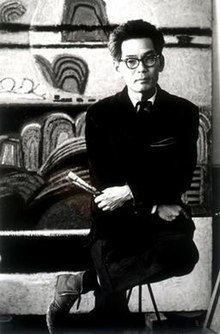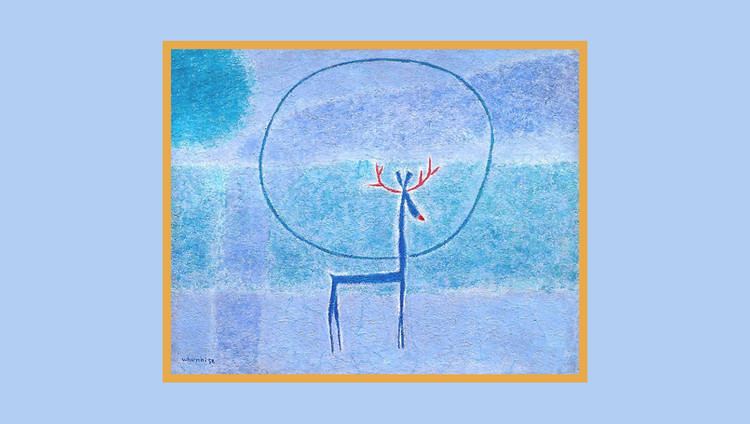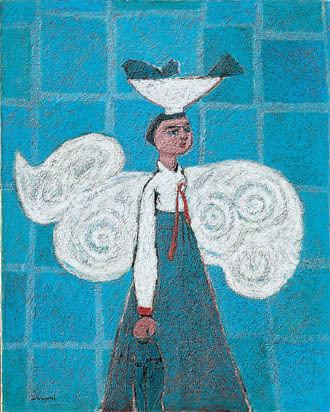Role Artist Known for Painting | Movement Abstract art Period Abstract art Name Whanki Kim | |
 | ||
Died July 25, 1974, New York City, New York, United States | ||
Kim Whanki, also Kim Whan-ki or Kim Hwan-gi (1913–1974, hangul: 김환기), was a pioneering abstract artist of Korea. Born February 27, 1913, in the village of Eupdong-ri on the island of Anjwado, Sinan County, South Jeolla Province, Kim died in New York City, USA, on July 25, 1974.
Contents
- Kim Whanki Universe 05 IV 71 200 1971
- Biography
- Tokyo 19311937
- Seoul 19381951
- Pusan 19511953
- Seoul 19531956
- Paris 19561959
- Seoul 19591963
- New York 19631974
- References

Kim belongs to the first generation of Korean Abstract artists, mixing oriental concepts and ideals with abstraction. With refined and moderated formative expression based on Korean Lyricism, he created his characteristic art world. His artworks largely dealt with diverse hues and patterns. Kim's early works were semi-abstract paintings which allowed beholders to see certain forms, but his later works were more deeply absorbed abstract paintings, filled with lines and spaces.

Respected domestically and abroad, the Whanki Museum, dedicated to Kim, opened in Seoul in 1992.

Kim Whanki, Universe 05-IV-71 #200, 1971
Biography

Growing up as the fourth child and only son of wealthy farmer Kim Sang-hyeon, Kim Whanki grew up comfortably and started studying abroad at the age of 19. His nephew's grandson is K-Pop male group BIGBANG main rapper, T.O.P.
Tokyo: 1931–1937

In 1931, he enrolled in Nishikishiro High School in Tokyo and continued to study at the College of Arts at Nihon University from 1933 until 1936. He even stayed an additional year as an assistant before returning to Korea in 1937. Kim's time in Tokyo supported his identity as an Abstract artist. In his university years, he was influenced by his mentors, Togo Seiji and Fujita Tsuguji, who had created new waves of Cubism and Futurism in Japan after having had direct interaction with Cubists and Futurist artists in Europe. His works of 1937 and 1938, such as Rondo, Aria, and White Seagull, are said to show a clear turn towards abstraction with their compositions of pure geometric shapes consisting of repeated rhythmic circular and oblong shapes with squares intersecting or overlapping. It was in Japan that Kim had his first solo exhibition. It took place at the Amagi Gallery, right before he returned home to Seoul. Kim left Tokyo in 1937, but he continued to submit works to the inaugural show of the Free Painters Exhibition in Japan until 1940.
Seoul: 1938–1951

After returning from his studies in Tokyo, Kim Whanki continued to get to know members of the Korean literary circle while gaining more interest in traditional Korean art. By 1940, this exhibition was no longer called the Free Painters Exhibition. It was called the Creative Artists Association, due to increasing military tensions that did not encourage new ideas. The Creative Artists Association made a branch in Korea and held its first exhibition in Seoul where Korean artists including Kim, as well as a number of Japanese artists, exhibited their work. Kim is said to have submitted six pieces: Island Tale, Still Life, Landscape 1, Landscape 2, Landscape at Atami, and Chamber Music before he left the Association in 1941.
During this time in Seoul Kim Whanki discovered the beauty represented by the white ceramic and wooden artifacts of the Yi Dynasty. The war years of 1942 to 1945 and of 1950 grew Kim's love for traditional Korean art. In the ‘50s, he started to use these artifacts as motifs in his paintings. He gained access to different works of ceramics and woodwork crafts and enjoyed observing them and talking about them for long periods.
Based on his submissions to the Neorealism exhibitions, Kim's works during 1942 and 1950 show inspiration from nature and everyday life. His desire to present pure composition and simplified objects is evident in work such as Woods.
Pusan: 1951–1953
During the Korean War, the Korean government moved to the southern port city of Pusan, along with many refugees. Whanki Kim also fled Seoul for safety in the South and entered a refugee camp for three years. These years are said to have been a time of suffering for Whanki Kim—his wife, Hyang-an Kim, recalls his strong rage and habit of drinking, though he did continue to paint. Some of the works produced during this time are Refugee Train, Landscape at Chin-hae, Shanty, and Jars and Women.
Seoul: 1953–1956
When Kim Whanki returned to Seoul in 1953, his obsession with jars grew once again and even more than before. He drew jars over and over again in his works including Jar and Poetry, White Jar and Woman, Jar, and Jar and Plum Blossoms. His return to Seoul also brought him to teach at the College of Fine Arts, Hongik University, to hold a one-man exhibition at the USIS Gallery, and to be elected a member of the Korean Academy.
Paris: 1956–1959
Kim's journals show that his departure for Paris was something he had been planning for quite a while. Starting in 1954, many Korean artists made this trip including Nam Kwan, Kim Heung-su, and Kim Chong-ha. Paris, the capital of the world of modern art, was the place that would cure them of their sense of inferiority, which had resulted from their negative experiences with Western art in Japan. Even though many artists and their works were significantly changed during trips abroad, Kim intentionally kept consistency and continued to portray motifs of jars, birds, mountains, deer, and plum blossoms. Away in France, Kim came to better understand and appreciate the unique qualities of Korea and Korean art.
Seoul: 1959–1963
On his return to Seoul in 1959 he was almost immediately offered the position of Dean of Faculty at the College of Fine Arts at Hongik University. In 1960, he became President of Hongik Art College. He found himself teaching and performing administrative duties more often than he was concentrating on art. He often felt frustrated during this time because of conflicts with other board members and the lack of connection between reality and what dreams he had for the institutions of art.
New York: 1963–1974
Kim Whanki left for New York in October 1963. This was the first year that Korea participated in the São Paulo Biennial, and Kim participated as a commissioner as well as a contributing artist. In this foreign land, Kim found confidence in his work and in Korean art.
During his career in New York, works depicting cosmic, planetary subjects, sound, echo, and music arose. In the second half of his time in New York, Kim spent much time on collages, papier-mâché works, and oil-on-newspaper paintings. It was during this time that Kim began to utilize dots in his works, sometimes even covering whole canvases with just dots, such as in Where and in What Form Are We to Meet Again? (1970).
